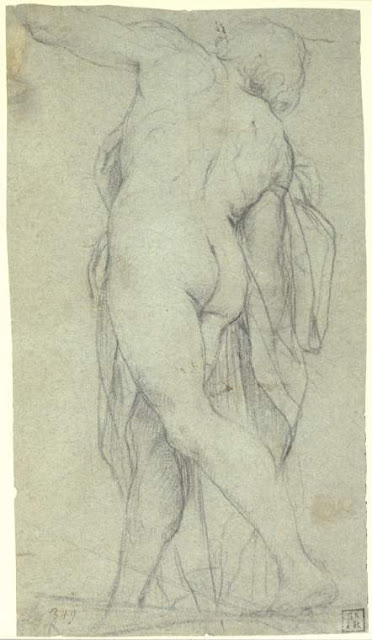 |
| Guido Reni Torso ca. 1620 drawing National Galleries of Scotland |
 |
| Guido Reni Triton before 1642 drawing Fitzwilliam Museum, Cambridge |
 |
| Guido Reni Sheet of studies for an Ascension of Christ and a St Jerome before 1642 drawing Fitzwilliam Museum, Cambridge |
from Mythestorema
We who set out on this pilgrimage
looked at the broken statues
became distracted and said that life is not so easily lost
that death has unexplored paths
and its own particular justice;
that while we, still upright on our feet, are dying,
affiliated in stone
united in hardness and weakness,
the ancient dead have escaped the circle and risen again
and smile in a strange silence.
– George Seferis, translated from Greek by Edmund Keeley
 |
| Anonymous Dutch artist after Abraham Bloemaert Seated soldier with drum, banner and pikestaff ca. 1650 drawing National Galleries of Scotland |
 |
| Guercino Study for the painting Erminia finding the wounded Tancred ca. 1650 drawing National Galleries of Scotland |
 |
| Jacob Jordaens Study for the nymph Adrastea for a ceiling painting of the Zodiac ca, 1641 drawing National Galleries of Scotland |
 |
| Anonymous Italian artist after Annibale Carracci Seated Apollo ca. 1600-1650 drawing National Galleries of Scotland |
 |
| Federico Barocci Study for Christ on the Cross before 1612 drawing Fitzwilliam Museum, Cambridge |
 |
| Federico Barocci Study for St Sebastian before 1612 drawing Fitzwilliam Museum, Cambridge |
 |
| Ludovico Carracci Back view of turning figure before 1619 drawing Fitzwilliam Museum, Cambridge |
 |
| Annibale Carracci Twisting torso before 1609 drawing Fitzwilliam Museum, Cambridge |
 |
| Agostino Carracci Adam and Eve before 1602 drawing National Galleries of Scotland |
 |
| Agostino Carracci Young Hercules before 1602 drawing Fitzwilliam Museum, Cambridge |
 |
| Annibale Carracci Back view of seated figure before 1609 drawing Fitzwilliam Museum, Cambridge |